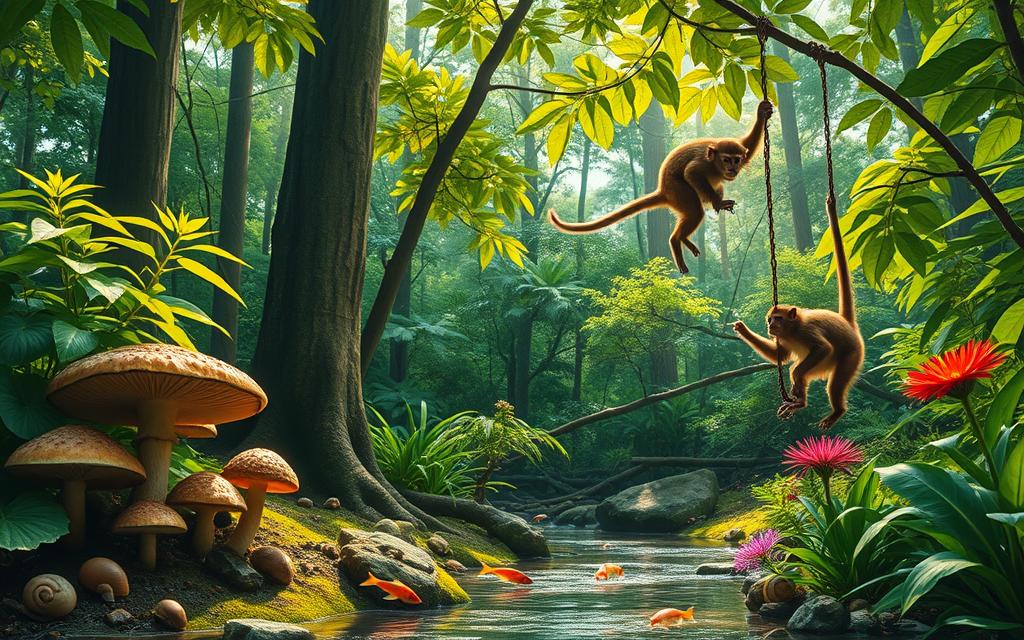
Discover Flora and Fauna in the Sacred Monkey Forest Sanctuary
Did you know the Sacred Monkey Forest Sanctuary in Bali is home to over 600 monkeys? These long-tailed macaques live in a place full of different plants and trees. Many of these plants and trees are important in Balinese culture1.
This area covers about 30 acres. It’s not just a home for wildlife. It also helps with keeping nature safe and protecting special places for animals2.
When you enter this magical forest, you’ll see how nature and culture come together. This sanctuary has been around since the 14th century. It shows how taking care of nature and believing in something spiritual can go hand in hand2.
Key Takeaways
- The Sacred Monkey Forest Sanctuary is a unique habitat for over 600 monkeys.
- Nearly 200 species of plants and trees can be found in the sanctuary.
- The sanctuary has a rich history linked to Balinese culture and conservation.
- Visitors can enjoy a variety of experiences while being responsible and respectful to nature.
- The entrance fee is 80,000 IDR on weekdays and 100,000 IDR on weekends.
Introduction to the Sacred Monkey Forest Sanctuary
The Sacred Monkey Forest Sanctuary in Bali is more than just a place for animals. It’s where cultural significance and ecological conservation come together. It’s a home for about 1,260 Balinese long-tailed macaques in 12.5 hectares of greenery and spiritual spots. Every month, over 10,000 people visit to see how animals and culture live together3.
There are over 186 tree species in the sanctuary, showing its rich biodiversity4. Walking through, you feel a deep respect for this place. It’s also a spot for traditional ceremonies and customs. The Padangtegal Wenara Wana Foundation manages it, teaching people about saving nature3.
The sanctuary is also a big draw for tourists. Adults and kids under three pay IDR 80,000 on weekdays to see its beauty and culture. It’s a small cost for seeing Bali’s stunning nature where animals and humans meet4.
Location and Accessibility
The Sacred Monkey Forest Sanctuary is in the heart of Ubud. It’s a top spot for tourists, easy to get to. It’s just 10 minutes by car or 2 kilometers from the town center. This makes it simple for visitors to see the area’s plants and animals.
Getting there is easy with many transport options. You can take a taxi, motorbike, or even walk. Walking lets you enjoy Ubud’s beautiful views. No matter how you get there, you’re in for a treat.
The sanctuary welcomes visitors from 9 a.m. to 6 p.m. every day. It’s a chance to dive into nature’s beauty. And it’s easy for everyone to get there5.
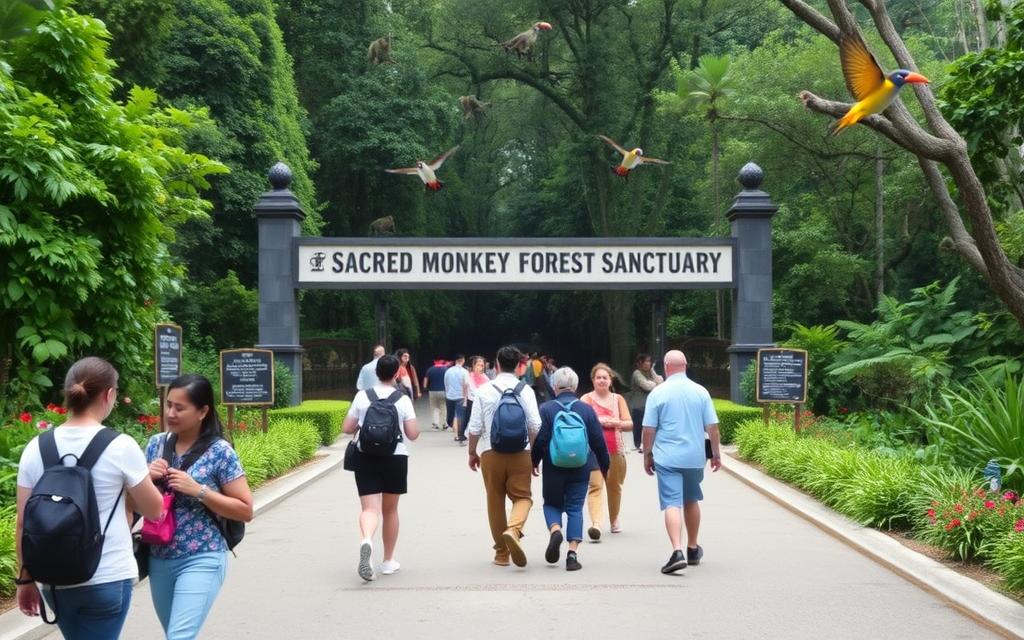
The Importance of Biodiversity in the Sanctuary
Biodiversity is key to the health of the Sacred Monkey Forest Sanctuary’s ecosystems. It brings together many native species for strong ecological interactions. These interactions are vital for ecosystem preservation. Every species, from big trees to hidden animals, makes the sanctuary stronger.
Genetic diversity helps species adapt to new conditions. It makes them more resistant to heat, cold, and diseases6. When you visit, you’ll see many native plants and animals. They are crucial to the ecosystem and important to local culture.
South Australia faces big challenges, with the highest mammal extinction rate in the world. By 2019, over 1,100 native species were at risk of disappearing6. Human actions, like harming habitats and introducing invasive species, are big reasons for this loss. This shows we need strong conservation efforts now.
The sanctuary works hard to protect native species and their homes. It aims to stop the decline of species and whole ecosystems6. Planting trees and shrubs is a key way to bring back biodiversity. It helps secure a future for these fragile ecosystems and their species7.
When you visit, your support helps the sanctuary and the world’s biodiversity. Every action to keep ecosystems healthy helps protect important cultures and the natural world.
Flora and Fauna in the Sanctuary
The Sacred Monkey Forest Sanctuary is full of life. It has over 186 types of plants. These plants are important to the area’s beauty.
You’ll see plants like the Pule Bandak and Majegan trees. They are key in Balinese rituals. Efforts to save these plants are vital for their survival8.
The Rich Plant Life of the Monkey Forest
Walking through the sanctuary, you’ll see many plants. These include trees, shrubs, and flowers. They are homes for many animals.
This variety of plants keeps the ecosystem healthy. It supports the animals that live there. Saving rare plants is important to protect birds and insects9.
Animal Life: The Monkeys and Beyond
The Balinese long-tailed macaques are the stars of the sanctuary. They live in groups and are fun to watch. Their actions affect the plants around them.
Other animals like the Timor rusa deer also call the sanctuary home. Seeing these animals helps us understand their importance in nature8.
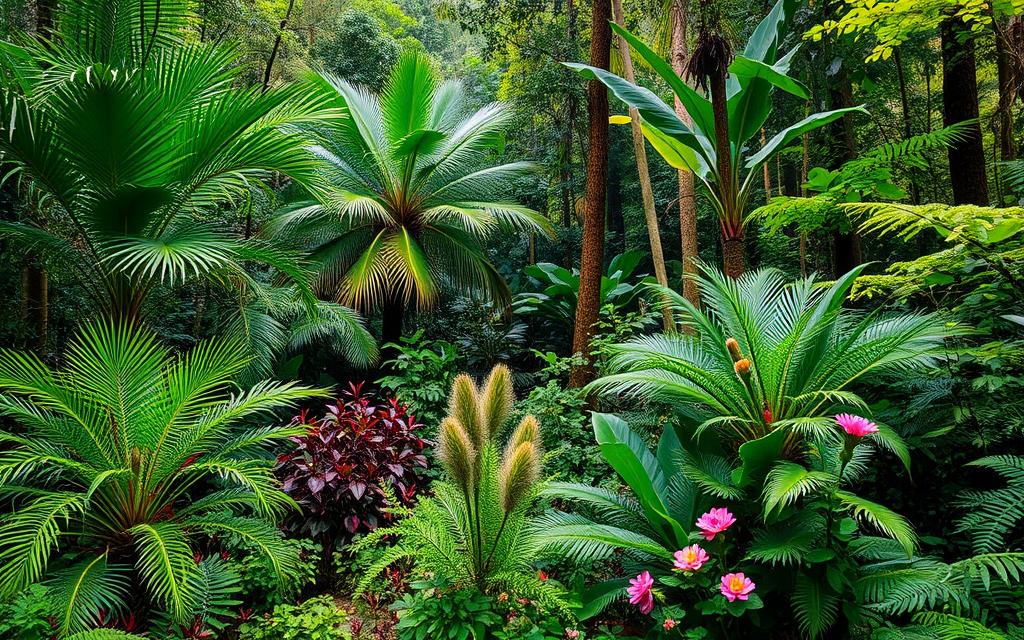
Understanding the Ecosystem Preservation Efforts
The Sacred Monkey Forest Sanctuary is key in saving nature. It helps animals and people through many conservation efforts. It focuses on saving animals that were hurt or left alone. Unlike zoos, it doesn’t breed animals or show them for fun, giving them a safe place10.
This place helps endangered species and fights against illegal wildlife trade10.
To keep nature in balance, the sanctuary uses smart management. It works on fixing habitats and watching animal numbers. Visitors must follow rules to keep safe from animals10.
Teaching people is important for saving nature. The sanctuary offers programs to teach about caring for wildlife10.
Working together with local people, officials, and experts is vital. This helps make good policies for the sanctuary10. By getting the community involved, the sanctuary protects its land and teaches people to care for the environment. This makes the Sacred Monkey Forest Sanctuary a great example of saving nature10.
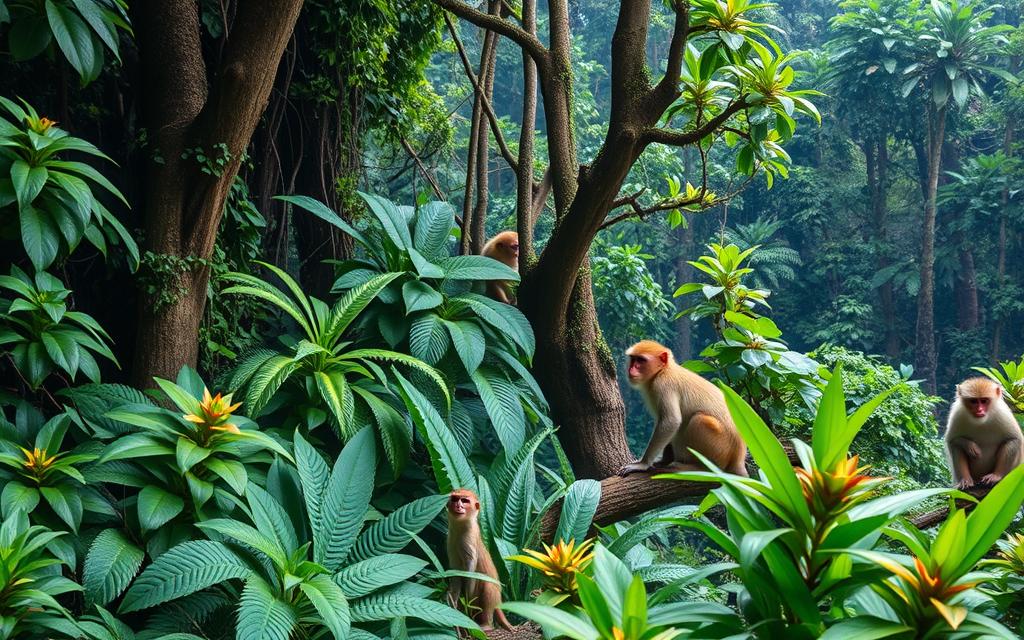
Endangered Species and Their Protection
In Australia, many species face big challenges, like the Balinese long-tailed macaque. By March 2021, 13 more species were added to the list of extinct ones. This brings the total to 100 since Europeans arrived in 178811. Australia has the highest rate of mammal extinctions, with over 1800 species at risk1112.
Conservation Status of Indigenous Wildlife
The Balinese long-tailed macaque is a key focus because of habitat loss and human impact. The sanctuary works hard to keep these primates healthy. It has agreements with the New South Wales National Parks and Wildlife Service to protect wildlife and habitats12.
Threats to Biodiversity and Mitigation Strategies
Understanding threats to the sanctuary is key. These include habitat loss, human-wildlife conflict, and too many tourists. The sanctuary fights these with education and rules against feeding the monkeys. Species like the Mountain Pygmy-possum and Eastern Quoll get help from better land management and population checks1112. Research-backed strategies help protect the sanctuary’s ecosystems.
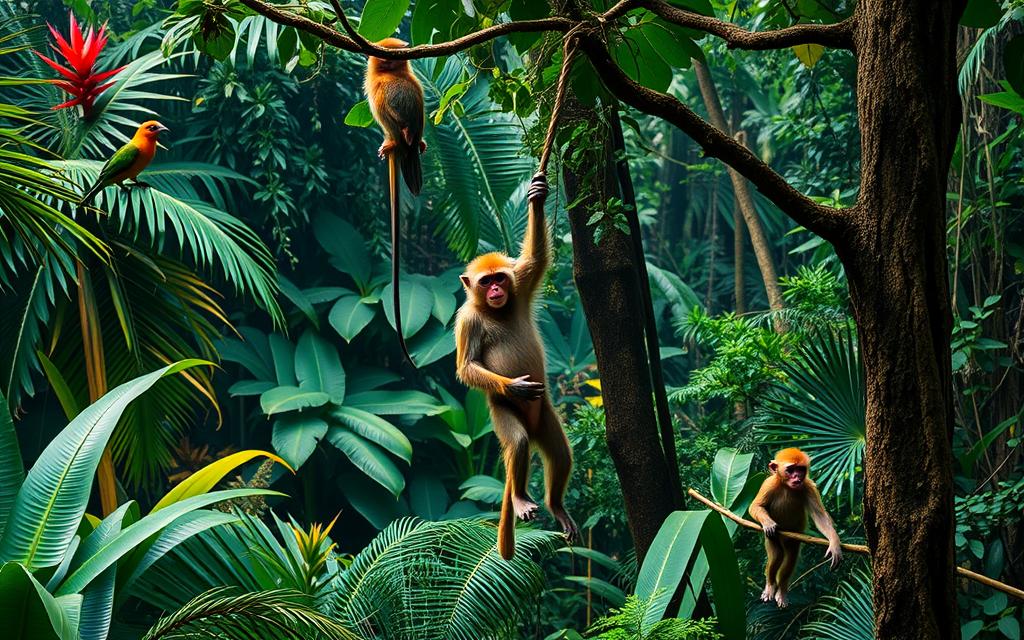
Ecotourism and Environmental Education Opportunities
The Sacred Monkey Forest Sanctuary is a top spot for ecotourism. It lets visitors learn about wildlife and local culture. You’ll get to know how to protect nature and its many species.
Guided tours show you how to watch monkeys in their home. They teach you to behave responsibly. This helps you connect more with the local ecosystem.
Workshops at the sanctuary will make you more knowledgeable. They’ll make you want to help protect nature. You’ll learn how supporting local businesses helps the environment.
The ecotourism market is growing fast, expected to hit $299.03 billion by 202613. This shows how important it is to visit places like the Sacred Monkey Forest responsibly.
Your visit helps protect animals and their homes. It’s not just good for you, but for the planet too. You’re part of a big effort to help nature and communities around the world13.
Role of Local Communities in Conservation
Local communities play a key role in saving places like the Sacred Monkey Forest Sanctuary. They see the forest as sacred and valuable, which makes them want to protect it. They connect with the land through traditional rituals.
Getting the community involved is crucial for conservation. It brings people together to achieve common goals. This leads to better ways to protect nature.
Local communities start small businesses that support sustainable tourism. This helps the local economy and keeps conservation efforts going. Projects like this have been shown to protect more species over time14.
When local people are involved from the start, conservation works better. Small changes in how land is managed can help both animals and people. The Sacred Monkey Forest Sanctuary shows how community efforts can help everyone1514.
Conclusion
The Sacred Monkey Forest Sanctuary shows how conservation, culture, and tourism come together. It’s a place where nature thrives and visitors have special experiences. By visiting, you help protect the monkeys and all the plants and animals living there. This is part of a bigger effort to save endangered species like the Great Indian Bustard and Asian Lions1617.
Visiting the Sacred Monkey Forest lets you see its beauty and learn about its ecosystems. You learn how your visit helps local communities and wildlife. It’s important to visit in a way that doesn’t harm nature. This way, you also learn about the challenges wildlife faces today18.
Your visit to the Sacred Monkey Forest helps with conservation and connects you with the local community. See it as more than a place to see animals. It’s a symbol of how humans and nature can work together. Your visit shows you care about our planet and helps protect it for the future.
FAQ
What is the Sacred Monkey Forest Sanctuary?
The Sacred Monkey Forest Sanctuary is in Ubud, Bali. It’s a place full of life and culture. It’s home to many plants and animals, especially the Balinese long-tailed macaque. It helps protect nature.
How can I access the Sanctuary?
You can get to the Sacred Monkey Forest Sanctuary by car in 10 minutes from Ubud’s center. Or, you can walk the 2-kilometer path. Taxis and motorbikes are also an option.
Why is biodiversity important in the Sanctuary?
Biodiversity keeps the Sanctuary’s ecosystem strong and healthy. It helps protect plants and animals. It’s key for saving endangered species and native plants.
What types of flora can I find in the Sanctuary?
You’ll find over 186 plant species, including sacred ones for Balinese rituals. Plants like the Pule Bandak and Majegan trees are special. Saving these plants is important for the Sanctuary.
Who oversees the conservation efforts in the Sanctuary?
Local communities, officials, and researchers work together to protect the Sanctuary. They use sustainable ways to keep wildlife and their homes safe.
What happens if I encounter monkeys during my visit?
Keep your distance from the monkeys and don’t feed them. Signs around the Sanctuary tell you how to interact with them.
How does the Sanctuary contribute to ecotourism?
The Sanctuary teaches visitors about saving wildlife and nature. It offers tours and workshops to learn more. This helps visitors understand the importance of the area.
What threats does the biodiversity face in the Sanctuary?
The Sanctuary faces threats like habitat loss, conflicts with humans, and too many visitors. It fights these with education and rules for visitors.
How can local communities influence the Sanctuary’s conservation practices?
Local communities help by honoring the land with rituals and supporting tourism. They share their knowledge to protect the Sanctuary.
Source Links
- https://finnsbeachclub.com/guides/monkey-forest-ubud/
- https://monkeyforestubud.com/about-us/
- https://en.wikipedia.org/wiki/Ubud_Monkey_Forest
- https://villaamrita.com/monkey-forest-ubud-in-bali/
- https://www.visitbrokenhill.com/Play/Living-Desert-State-Park/John-Simons-Flora-Fauna-Sanctuary
- https://www.environment.sa.gov.au/topics/biodiversity/about-biodiversity
- https://www.georgesriver.nsw.gov.au/Environment/Biodiversity
- https://blackburnlakesanctuary.org/animals-of-the-sanctuary/
- https://blackburnlakesanctuary.org/plants-of-the-sanctuary/
- https://sandiegoanimalsanctuaryandfarm.org/animal-sanctuaries-101-understanding-their-mission-and-importance/
- https://www.natureaustralia.org.au/what-we-do/our-priorities/wildlife/wildlife-stories/australias-endangered-animals/
- https://www.australianwildlifesanctuary.com.au/fight
- https://2minute.org/article/25
- https://communityconservation.org/our-work/what-is-community-conservation/
- https://www.ncbi.nlm.nih.gov/pmc/articles/PMC2039772/
- https://unacademy.com/content/neet-ug/study-material/biology/wildlife-sanctuary-and-national-park/
- https://unacademy.com/content/neet-ug/study-material/biology/wildlife-sanctuary/
- https://byjus.com/biology/wildlife-sanctuary/